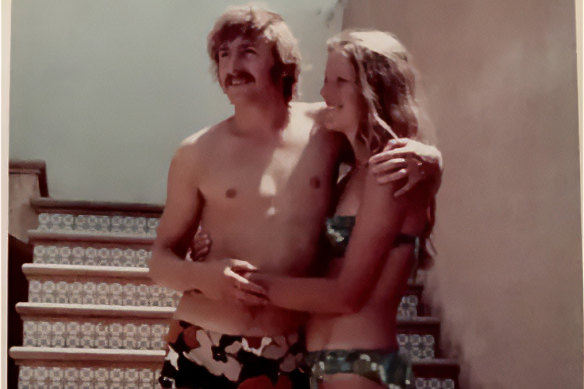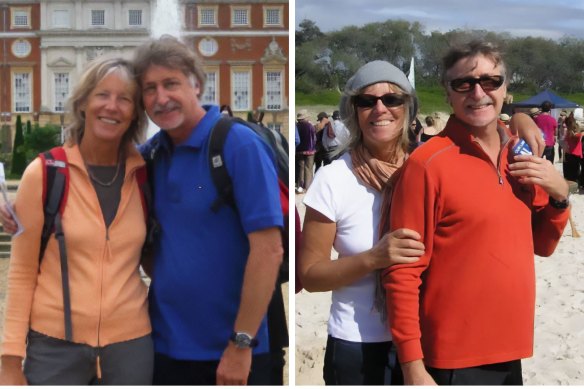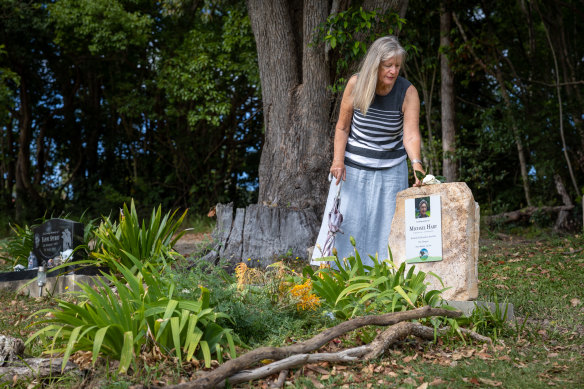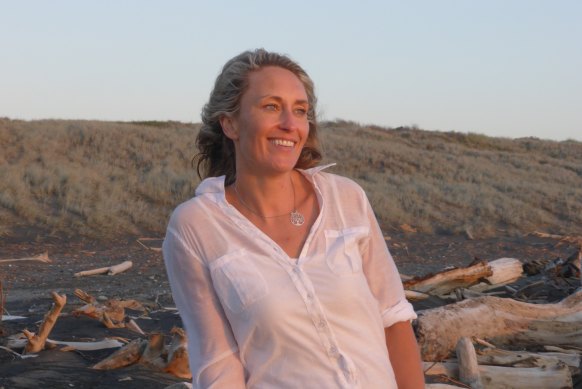A woman’s final act of love to ensure her husband died the way he lived
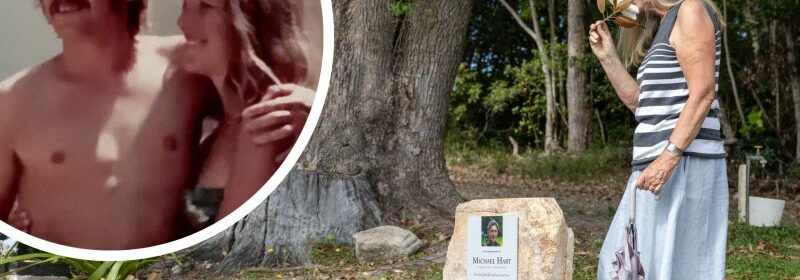
Di Hart was 16 when she first met a young musician called Michael. She was volunteering at a club for teenagers with disabilities in London. He was in the band.
“I liked him straight away,” she says. “When all the other band members pissed off to the pub at half-time, he stayed and played card games with the clients.”
Di and Michael Hart on their honeymoon in Ibiza in 1972.
Fifty-four years later, and 16,500 kilometres away from that English club, Michael died. Hart was by his side, at the home the couple shared in Mullumbimby. She was consumed with grief, but a friend gave her a simple piece of advice.
“She said, ‘I know you don’t want to do the funeral, that you want to crawl into a hole with a bottle of gin, I get it. But this will sustain you in the dark times to come.’”
So Hart, who had spent her life with Michael caring for the environment, dressed her husband in his favourite sarong and Batik shirt and laid him out in a recycled cardboard coffin. Her children wrote messages to their dad on the outside and filled the coffin to the brim with natural flowers.
Then they walked to the local cemetery, sang songs together, and buried Michael on top of a pile of green material, to make sure he was at the best depth in the grave for decomposition – “in the living part of the soil”.
Di Hart and her husband Michael.
“He got recycled,” Hart says of her husband of 48 years. “It was one of the most beautiful experiences, to experience Michael’s funeral.
“We’re a valuable resource and we should be returning our bodies to the soil in a way that they get recycled.”
There is growing awareness across Australia about the environmental impact of death. Traditional burials tend to use embalming fluid and plastic-lined coffins. Cremations, often powered by fossil fuels, can emit carbon dioxide, sulphur dioxide, and mercury from tooth fillings.
For years, Hart has been advocating for a “natural burial ground” in Byron Shire to address these issues, but Michael died in 2020, before her group of volunteers had managed to establish one.
Di Hart visits the burial site of her husband, Michael, at Mullumbimby. Her family made the headstone themselves.Credit:Danielle Smith
In a natural burial ground, bodies are buried about 1.2 metres deep, without embalming, in biodegradable coffins and with natural fabrics. There are no headstones, just GPS locators buried with the body. Instead of visiting a cemetery, the idea is that grieving families visit a regenerated, living forest.
Byron Shire Council abandoned plans for a natural burial ground in Mullumbimby last November, after a report found the soil was too heavy and wet and too poor quality to allow for easy decomposition. Hart disputes these findings.
The council will now investigate the suitability of two other sites in the shire, but Hart says it is a blow for more than 350 people, some of whom are nearing the end of their lives, who have said they want to be buried at the site.
Meanwhile, at the other end of the state, in Bodalla, plans are afoot to open what is believed to be the NSW’s first standalone natural burial ground.
Fiona McCuaig plans to establish a natural burial ground on the NSW South Coast.
Fiona McCuaig won council approval last year to set up the burial ground on her parents’ farm, and hopes to use it to regenerate the agricultural land and provide habitat for lyrebirds and black cockatoos.
She expects the site to open next year. “They have done studies with grieving and bereavement, and found that for people who are grieving, it is so much nicer to visit a place that is full of life.
“Traditional burials are now seen to some people as underground landfill. We’re taking it back to what we’ve done for 99 per cent of human existence, which is to simply put our bodies back in the ground for future life.”
A handful of cemeteries have a natural burial section in NSW, but advocates say the gold standard is a standalone site because it allows for regeneration and conservation of the land.
Natural Deaths Advocacy Network president Bec Lyons says the process also helps families with their grief. “They encourage families to make sure that the last thing they do for their loved person is an act of service.”
Hart says the final acts of service she carried out for Michael sustained her through her grief, as her friend told her they would.
She has realised she wants to be buried beside Michael, in the same environmentally friendly way, and has reserved the adjoining plot at the local cemetery.
But she is still advocating for a Byron natural burial ground. She says it is essential Australia embraces standalone natural burial grounds.
“We cannot keep putting people in traditional cemeteries and cremating them. It’s unsustainable.
“Do you want your final resting place to be part of the problem or part of the solution? For me, it’s just a no-brainer.”
The Morning Edition newsletter is our guide to the day’s most important and interesting stories, analysis and insights. Sign up here.
Most Viewed in Environment
From our partners
Source: Read Full Article
